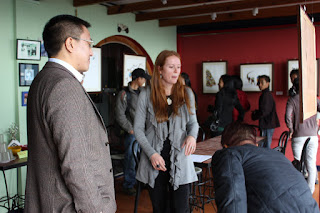
It was quite an honor to find out that I was the first artist to be invited to Nagaland and to know this was the first formal art exhibition to ever be held in the state. We had a press conference immediately following our arrival at the airport and the three major newspapers from Northeast India printed articles about the exhibition the day it opened, followed by additional articles and television segments the next day. I exhibited 14 paintings through two spaces (one of which is shown in these photos), gave a short artist talk at the reception, and gave a longer artist lecture followed by a lively discussion the following night.
The Commissioner and Secretary of Art, Culture, and Tourism, Shri. Himato Zhimomi, inaugurated the event with a ribbon cutting ceremony and gave a truly inspiring speech about the critical role that art will play in preserving the history and defining the future of Nagaland. He emphasized (I blogged about this before but it's worth repeating) the family in the United States that is giving their extensive collection of Naga art back to Nagaland as a turning point in their efforts. He finished by promising full support for emerging Naga artists and for continuing the example of art exhibitions and related events as exemplified by "the developed world".
Throughout the week, Brian and I met with many Naga artists and musicians. The major challenge that visual artists are facing is that there aren't any exhibition spaces in the entire state of Nagaland--not one. There are three small museums holding primarily WWII artifacts in Kohima, Kisama, and Mopunchuket, but they are not able to accommodate 21st century art and they are far from what they could be. When I asked about the possibility of starting a gallery in an abandoned building or in an empty store space, they unanimously responded that there aren't any abandoned buildings or empty storefronts. In one of our brainstorming sessions over dinner, artists talked about the possibility of securing government funds to start a retreat center outside of Kohima that would have three parts: an exhibition space, a open space for artists to work without invitations or reservations, and living quarters for an artist-in-residence.
Throughout our travels through the state, I found there to be a very high degree of sophistication amongst the Naga artists, musicians, filmmakers, and University students--far more than they were giving themselves credit for. The greatest obstacles that I perceived were not about the art itself but rather the presence of infrastructure for display and performance and the level of confidence that the artists (and students) have in what they are already doing. Both of these obstacles are being dismantled with great momentum. The Press Secretary for Nagaland himself vowed full support for emerging filmmakers and has followed through, in only a week's time, with paying for "The Headhunters" to come to Nazareth College to work with Brian this summer (as he already wrote about). I give a tremendous amount of credit to Theja Meru for exemplifying the impact that one person can make on a much larger society. Thanks to his determination, we inaugurated the first art exhibition, the first youth film festival, and the first International Photography Exhibition all in one week.




No comments:
Post a Comment